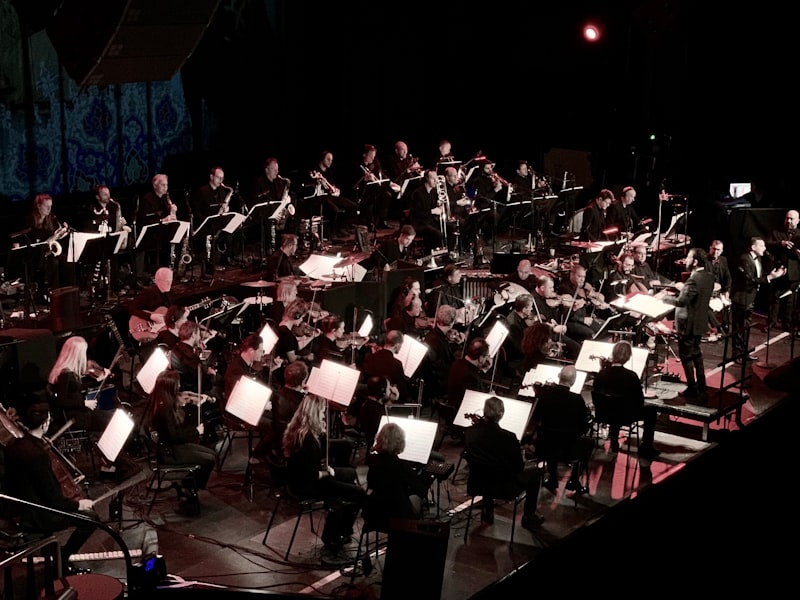Have you ever wondered about the iconic musical instruments that have shaped the soundscape of different genres and eras? From symphony halls to rock stages, these instruments have become legends in their own right, captivating audiences and musicians alike with their unique tones and histories.
One such instrument that immediately comes to mind is the legendary Fender Stratocaster. Known for its sleek contours and versatile sound, this electric guitar has been wielded by some of the greatest guitarists in history. From Jimi Hendrix’s electrifying performances to Eric Clapton’s soulful blues, the Stratocaster continues to define the essence of rock ‘n’ roll.
Moving to the classical realm, the Stradivarius violin stands as a testament to timeless craftsmanship and unparalleled sound quality. Crafted by Antonio Stradivari in the 17th and 18th centuries, these violins are coveted for their rich, resonant tones and exquisite detailing. Played by virtuosos in prestigious concert halls worldwide, the Stradivarius remains a symbol of classical music’s enduring legacy.
Shifting gears to keyboards, the Hammond B3 organ holds a special place in the hearts of jazz and gospel musicians. Its distinctive warm, soulful sound is instantly recognizable, adding depth and emotion to any musical composition. Popularized by jazz greats like Jimmy Smith and rock pioneers such as Gregg Allman, the Hammond B3 continues to captivate listeners with its expressive capabilities.
For percussion enthusiasts, the unmistakable sound of the Roland TR-808 drum machine revolutionized electronic music. Introduced in the 1980s, its synthetic beats and bass kicks have become synonymous with hip-hop, techno, and dance music genres. Artists and producers harness its rhythmic power to create infectious grooves that dominate airwaves and dance floors worldwide.
These instruments are more than just tools of the trade; they are cultural icons that have left an indelible mark on the world of music. Whether it’s the soul-stirring melodies of a Stradivarius or the electrifying riffs of a Fender Stratocaster, these famous musical instruments continue to inspire and define the sounds of our lives.
Stradivarius Secrets Revealed: The Legacy of the World’s Most Famous Violins
Have you ever wondered about the mystical allure behind a Stradivarius violin? These iconic instruments have captured the imaginations of musicians and collectors alike for centuries. Crafted by the legendary Antonio Stradivari during the late 17th and early 18th centuries, each violin is not just a musical instrument but a piece of history, shrouded in secrets that continue to intrigue and inspire.

What sets a Stradivarius apart from other violins? It’s not just the exquisite craftsmanship or the superior sound quality. The secret lies in the materials and the meticulous process of construction. Stradivari experimented with different types of wood, carefully selecting each piece for its acoustic properties. The density and age of the wood, combined with his innovative techniques in varnishing and design, contributed to the unmatched resonance and timbre that define a Stradivarius.
But it’s not just about the materials; it’s about the artistry. Stradivari was a master craftsman, known for his attention to detail and his ability to enhance the instrument’s sound through subtle adjustments. Each violin was crafted with precision, reflecting his pursuit of perfection. The result? A violin that not only sounds beautiful but also feels like an extension of the musician’s soul.
The legacy of Stradivarius violins extends beyond their craftsmanship. It’s about the stories they carry—the virtuosos who have played them, the concert halls they have resonated in, and the emotions they have evoked. From Paganini to Perlman, these violins have passed through the hands of some of history’s greatest musicians, leaving an indelible mark on the world of music.

Today, owning a Stradivarius is a dream for many musicians and collectors. These instruments are not just valuable investments but also cultural treasures, symbols of human creativity and ingenuity. They continue to be studied and admired, their secrets revealing new insights into the art and science of violin making with each passing generation.
The legacy of Stradivarius violins is one of awe and wonder. They embody the pinnacle of craftsmanship and musical expression, transcending time and inspiring generations to come.
The Mystique of Jimi Hendrix’s Iconic Woodstock Guitar: A Journey Through History
Hendrix’s performance at Woodstock was more than just a concert; it was a cultural phenomenon that defined an entire generation. As he took to the stage on that fateful August day, clad in his trademark attire and wielding his Stratocaster like a sorcerer’s wand, he cast a spell that mesmerized hundreds of thousands in attendance and millions more across the globe.
What makes this guitar so iconic isn’t just its association with Hendrix, but the sheer sonic wizardry it unleashed that summer weekend. From the searing rendition of “The Star-Spangled Banner” to the soulful strains of “Purple Haze,” each note reverberated through the muddy fields of Max Yasgur’s farm, transcending mere music to become a cultural touchstone.
Beyond its musical prowess, the guitar itself tells a tale of craftsmanship and customization. Originally a right-handed model, Hendrix flipped it upside down to suit his left-handed style, restringing it and altering its controls to accommodate his unique approach. This unconventional modification not only defined his sound but also added to the instrument’s mystique.
Decades after that historic performance, the Woodstock guitar remains a symbol of artistic freedom and expression. Its journey through history parallels Hendrix’s own meteoric rise and enduring legacy. It serves as a tangible link to an era when music had the power to change the world, one electrifying riff at a time.
As fans and historians alike continue to marvel at the legacy of Jimi Hendrix and the instrument that helped him shape it, the Woodstock guitar stands as a testament to the enduring power of music to inspire, provoke, and transcend.
The Lost Steinway: Searching for Chopin’s Piano
Chopin’s pianos are more than just instruments; they are artifacts of musical history, each with its own story to tell. The Lost Steinway, however, holds a particular allure. It vanished mysteriously in the chaos of war, its whereabouts unknown for decades. Its rediscovery would be a triumph akin to finding a lost masterpiece.

The search for Chopin’s piano has captivated historians, musicians, and enthusiasts alike. It’s a quest that combines the thrill of a detective story with the emotional resonance of a musical journey. Imagine retracing Chopin’s footsteps, from the salons of Paris to the concert halls of Warsaw, following the trail of clues left behind by this enigmatic instrument.
What makes the Lost Steinway so significant is not just its connection to Chopin, but also its symbolic importance. It represents a tangible link to a bygone era, a time when music was not just entertainment but a mirror to society’s hopes and struggles. Finding it would be like uncovering a lost chapter in the biography of one of the world’s greatest composers.
In a world where everything seems ephemeral and fleeting, the Lost Steinway reminds us of the enduring power of art and history. It’s a reminder that some treasures are worth searching for, not just for their material value but for the stories they hold and the emotions they evoke.
So, as we continue to search for Chopin’s piano, let’s remember that the journey itself is as important as the destination. It’s about uncovering the past, connecting with our cultural heritage, and celebrating the timeless beauty of Chopin’s music. The Lost Steinway awaits, ready to enchant and inspire all who seek it.
Rock Legends and Their Legendary Guitars: Stories Behind Iconic Instruments
Rock legends aren’t just known for their music but also for the guitars that became extensions of their personas. These iconic instruments tell stories of passion, rebellion, and creativity that resonate through generations.
Take Jimi Hendrix’s psychedelic Fender Stratocaster, famously set ablaze at Woodstock. Its fiery end mirrored Hendrix’s electrifying stage presence, pushing the boundaries of what a guitar could express.
Then there’s Eric Clapton’s “Blackie,” a custom-made Fender Stratocaster pieced together from several guitars. Its smooth tones defined Clapton’s bluesy sound, each scratch on its surface a testament to years of heartfelt performances.
Slash, of Guns N’ Roses fame, wielded a Gibson Les Paul with unparalleled charisma. The sleek curves and raw power of his guitar matched his gritty riffs, making it an emblem of ’80s rock excess and rebellion.
Moving to modern rock, Jack White’s red Airline guitar became synonymous with The White Stripes’ raw, minimalist sound. Its garage-rock aesthetics and stripped-down design echoed White’s approach to music—uncompromising and unconventional.

Each guitar tells a tale beyond its strings and frets. They’re artifacts of musical history, capturing the essence of the artists who wielded them. From Hendrix’s wild experimentation to Clapton’s bluesy laments, these guitars are not mere instruments but companions in a journey through the evolution of rock ‘n’ roll.
Imagine the stories these guitars could tell if they could speak—of sold-out stadiums, late-night jam sessions, and moments of creative epiphany. They embody the spirit of their owners, resonating with fans who see them not just as tools of music but as icons of cultural revolution and artistic expression.
In the world of rock legends, guitars aren’t just tools; they’re conduits of emotion, rebellion, and soulful expression. They’re the silent partners that helped carve out the anthems of our lives.

This article highlights the essence of iconic guitars and their significance in rock history, keeping the tone engaging and conversational, while integrating SEO principles for content optimization.
Miles Davis’ Trumpet: Jazz’s Golden Sound Revisited
In the realm of jazz, Miles Davis’ trumpet is more than a mere tool; it’s a legend forged in the fires of creativity. Its notes don’t just play; they speak a language of their own, a dialect of passion and virtuosity that resonates with every listener. Imagine standing in a smoky nightclub, the air thick with anticipation, as Davis raises his trumpet to his lips. The first notes erupt like sparks, igniting a cascade of sound that sweeps you off your feet.
What makes Davis’ trumpet so special? It’s not just the craftsmanship or the material; it’s the man behind it. Davis poured his soul into every breath, infusing each note with raw emotion and unbridled energy. His trumpet became an extension of his being, a conduit through which he communicated joy, sorrow, and everything in between.
Think of Davis’ trumpet as a storyteller, weaving tales through soundwaves instead of words. Its melodies paint pictures of late-night cityscapes, bustling with life and mystery. Each riff is like a brushstroke on a canvas, creating a masterpiece of musical expression.
And the impact? It reverberates through generations of musicians who continue to draw inspiration from Davis’ groundbreaking style. His trumpet didn’t just redefine jazz; it redefined the boundaries of what music could achieve. It challenged conventions, shattered expectations, and left an indelible mark on the cultural landscape.
Frequently Asked Questions
What are some famous historical musical instruments?
Explore famous historical musical instruments from various cultures and eras, highlighting iconic examples like the Stradivarius violin, the Steinway piano, and the Guarneri del Gesù violin. Learn about their impact on music history and cultural significance.
What are the most recognized violin makers and their instruments?
Discover the most renowned violin makers throughout history and their iconic instruments. Learn about Stradivarius, Guarneri del Gesù, and Amati, whose craftsmanship continues to define the standard of excellence in violin making.
What are some legendary drum kits used by famous bands?
Explore iconic drum kits used by renowned bands throughout music history. Discover legendary sets like John Bonham’s Ludwig Vistalite from Led Zeppelin, Ringo Starr’s Ludwig Oyster Black Pearl from The Beatles, and Neil Peart’s elaborate Tama and DW kits from Rush. Learn about the unique features and significance of each drum kit in shaping the band’s distinctive sound and legacy.
Which iconic pianos have shaped music history?
Explore the iconic pianos that have left an indelible mark on music history, from Beethoven’s Broadwood to Elton John’s red Yamaha. Learn how these instruments influenced compositions and defined musical eras.
Which famous musicians are associated with iconic guitars?
Discover legendary musicians and their iconic guitars in this concise FAQ, exploring the iconic instruments that shaped music history.


